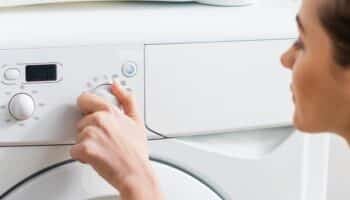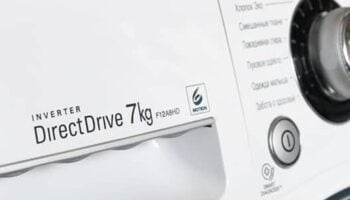We've independently reviewed this article to make sure it's as accurate as we can make it.
To find out more about our article creation and review process, check out our editorial guidelines.
Is your Whirlpool Washer refusing to spin?
You’re not alone. A washer that stops spinning can be quite a common problem – and can usually be linked back to one of several issues.
But don’t worry! I’m here to help.
If your Whirlpool washer won’t spin, there’s a good chance it’s overloaded, the drain pump is clogged, or the motor coupling is broken. A loose drive belt, a faulty door lock, or a malfunctioning lid switch can also explain the issue.
Read on to get your washer spinning again!
6 Reasons Why Your Whirlpool Washer Won’t Spin
Multiple reasons could explain why your Whirlpool washer is having spinning issues.
In this section, I’ll guide you through the most common ones and provide different solutions.
#1 An Overloaded Whirlpool Washer
My usual advice when fixing spinning issues on a Whirlpool washer is to ensure the unit is not overloaded with clothes.
Ensuring the closed are evenly distributed around the agitator is also crucial.
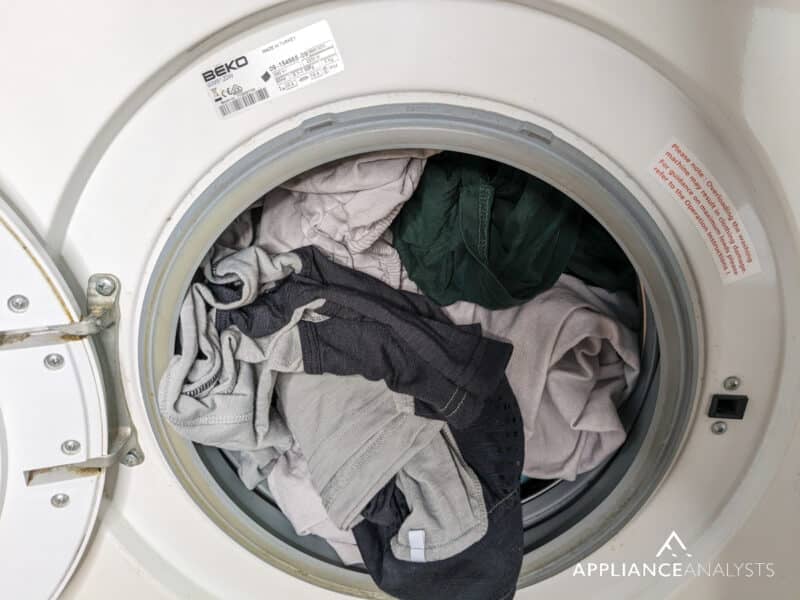
You see, if your Whirlpool washer is unbalanced or overloaded, it won’t be able to spin, and you’ll end up with soaking wet clothes.
Try rearranging your clothes; it’s important to maintain the washer’s load between 1/4 and 3/4 of its capacity. Then, run the cycle again to see if your washer is spinning.
#2 A Clogged or Damaged Drain Pump Filter
When I see a Whirlpool washer not spinning, I always check the drain pump.
The drain pump is in charge of directing the water through the drain hose. But if a foreign object gets trapped in it, your Whirlpool washer will have spinning issues.
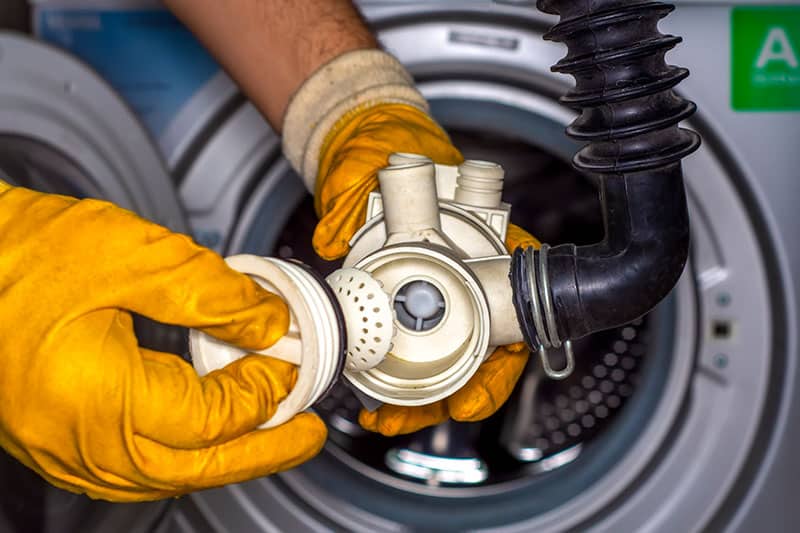
You’ll need to unclog your drain pump filter to solve the issue. Follow this quick guide to do it:
- Unplug your Whirlpool washing machine and elevate the front by placing blocks under each foot.
- Unscrew the three screws at the bottom of your washer to remove the panel and access the drain pump. Store them somewhere safe because you’ll use them later.
- Drain the hose water by placing a container under the drain pump and turning the knob counterclockwise.
- Turn the knob over and check the filter. Please remove any foreign objects or debris.
- Put the drain filter on the pump again, and take your washer off the blocks.
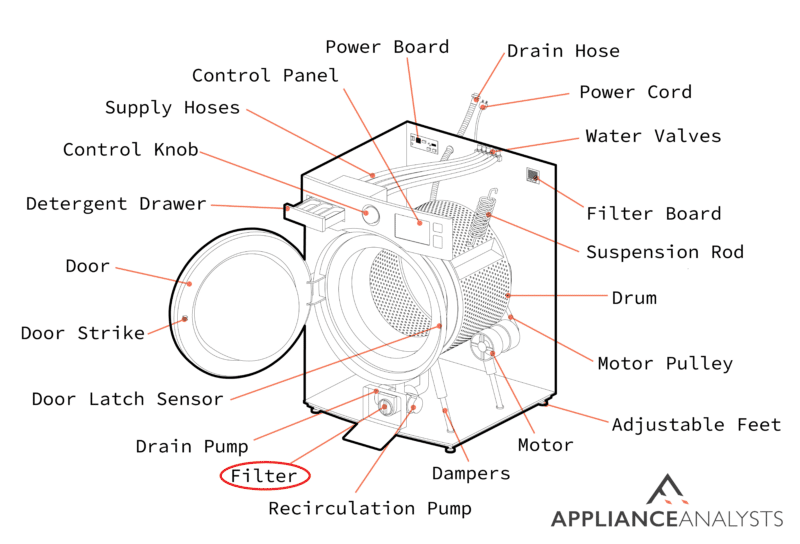
Once you’ve completed the steps above, try starting a new cycle to see if your Whirlpool washer spins. If the issue persists, the drain pump is likely damaged, and you’ll need to replace it.
#3 A Broken Motor Coupling
When fixing a Whirlpool washer that won’t spin, I recommend checking the motor coupling.
You see, if your washer is old, the motor coupling can be broken or damaged, resulting in spinning issues.
But don’t worry. You can replace the motor coupling by calling a professional or by following this quick guide:
- Unplug your appliance and turn off the water supply. Then, disconnect the supply lines in your Whirlpool washer’s back.
- Check your manual and access the interior of the machine.
- Remove the pump to access the motor by unclipping the retainer clips and pulling the pump off the motor shaft.
- Unplug the motor’s wiring harness.
- Use a nut driver to remove the screws at the top and bottom of the motor holding the retainer clips. Bear in mind that the motor is heavy.
- Remove the old coupler parts and replace the motor couple with a new one.
- Reassemble the washing machine and plug it back into the water supply and wall outlet.
#4 A Loose Drive Belt
If your Whirlpool washer is still struggling with spinning issues, you likely have a loose drive belt.
You see, the drive belt allows the drum to turn during a wash cycle. So, if it’s loose or broken, your Whirlpool washer won’t spin.
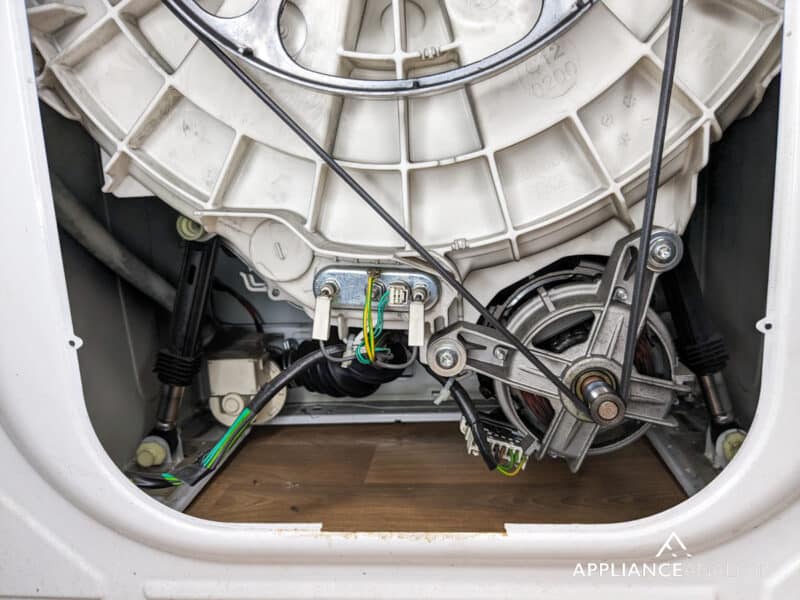
In my opinion, fixing the drive belt is relatively simple. Here’s how to do it:
- Unplug your washer from the wall outlet and turn off the water supply. You’ll need to disconnect the water supply lines.
- Remove the back panel of your appliance to check the drive belt (wide black rubber strip). Please make sure it’s not damaged.
- If you need to replace it, rotate the tub drive pulley. The belt will fall off.
- Slide one end of the new drive belt over the motor pulley and place the other end on the tub drive pulley. Rotate the pulley to secure the belt.
- Reconnect your Whirlpool washer and start a wash cycle to see if the issue was solved.
#5 Damaged Door Lock (Front-Load Whirlpool Washers)
My usual advice for homeowners with a front-load Whirlpool washer that doesn’t spin is to check the door lock.
You see, the door lock ensures the door remains securely closed during the washing cycle. If damaged, it will not engage properly, and the spin cycle won’t start.
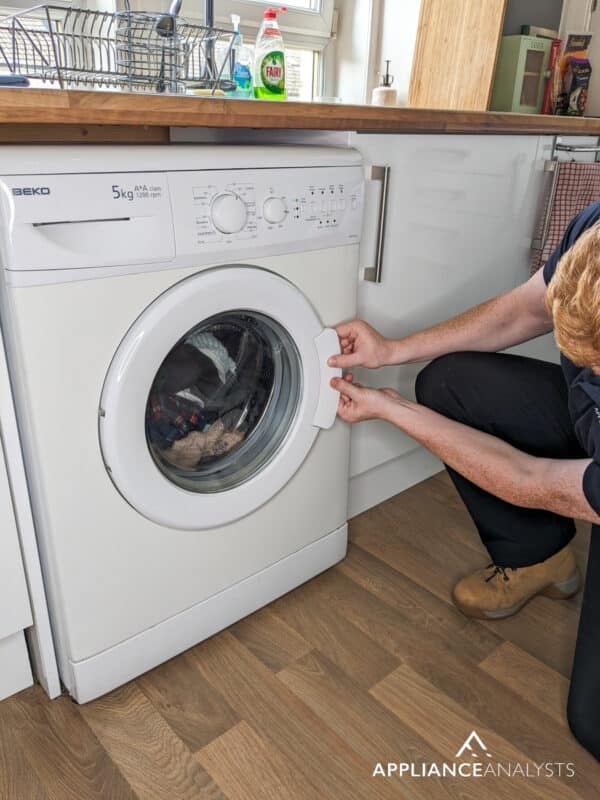
To check the door lock, you’ll need to.
- Unplug your washer.
- Unscrew the three screws of the top panel at the back of your washer. Lift the panel off.
- Open the door and remove the bellow spring by placing a flat screwdriver on the loop where the water attaches.
- Pull back the boot to access the door lock and remove the screws that hold the door lock.
- Reach inside the washer and lift the door lock assembly. Then, disconnect the attached wires and remove the door lock.
- Test the door lock with a multimeter and compare the reading to the manufacturer’s recommendations. If it’s damaged, please replace it.
If you’re a visual learner, there are multiple videos on YouTube that can guide you.
#6 Faulty Lid Switch (Whirlpool Top-Load Washers)
If your top-load Whirlpool washer won’t spin, check the lid switch.
The lid switch allows your washer to start when the lid is closed. However, if it’s damaged, it can think that the lid is open and the spin cycle won’t start.
But don’t worry. You can easily solve the spinning issue by installing a new switch lid. Here’s how to do it:
- Turn off all electricity: When plugged in, the wires in your Whirlpool washer have currents of electricity running through them at all times. Turn off and unplug your machine to be completely safe.
- Unscrew the control panel: You can remove the control panel by taking off two screws that rest on either side of the machine. Then, pull it straight off your washer. Keep in mind that it can take a little more effort if this is your first time, as manufacturers will try to make the panel as tight-fitting as possible to avoid any future issues.
- Unplug the lid switch: Once the control panel is up, you’ll see the lid switch attached to the washer’s base. The part that plugs into your lid switch will come from the control panel and will have three wires coming out of one side. Unplug the lid switch from the washer so you can test its status.
- Test the lid switch: The three wires from your lid switch will have different colors. There is always a green color included in the three. Avoid the green color when testing because this color plugs into the washer, not the lid switch. Take your ohmmeter and plug the red and black ends into the appropriate ends of the lid switch. If you hear a buzzing sound, then you have a closed circuit, which means the lid switch is in good condition. No sound means your lid switch needs replacing because it doesn’t recognize when your Whirlpool washing lid is locked and secure.
- Replace the lid switch: Carefully remove the lid switch from the base of the washer completely so you can replace it. Reverse the order of steps you used to uninstall the piece to put everything back together again.
Check out our maintenance guide to make the most out of your Whirlpool washer and prevent spinning issues from reappearing!
FAQ
How Do You Reset a Whirlpool Washer?
Unplug the washer from the outlet and wait about one minute before plugging it back in. Now, your machine will give you 30 seconds to lift the lid at least once to start the reset process.
Once you lift the lid, though, you only have 12 seconds to finish lifting and closing the lid six total times to start the reset process.
Some machines have a clicking sound when closing and opening it, giving you a clear sign when you’re doing it right. Once you’ve reset the motor, start another load.
How Long Do Whirlpool Washers Last?
Your Whirlpool washer should last anywhere from 12-14 years if you take care of it properly. This will depend on your use and the type of load.
If you have a large family and need to wash several times a week, then your machine won’t last as long as someone who is single and only needs to wash once a week.
Also, how many clothes you put in your washer at one time will put more or less stress on the machine. Keep to small loads for a longer life span for your Whirlpool washer.
Can You Bypass the Lid Switch?
It’s not recommended to bypass the lid switch because your washer won’t know if the lid is securely locked in place. If someone were to open the lid, there could be an accident, or the machine could be damaged.
That being said, it is possible to bypass a lid switch if you have extra wire and have some experience with open and closed currents.
Conclusion
Hopefully, now you’ll be able to solve the problem that was keeping your Whirlpool washer from spinning.
Remember, you can solve spinning issues by ensuring the washer is not overloaded or unbalanced, checking the drain pump, and inspecting the motor coupling. Don’t forget to look at the door lock or lid switch.
Thank you so much for reading! Please check out our other free guides if you found this article helpful.
Good luck!







